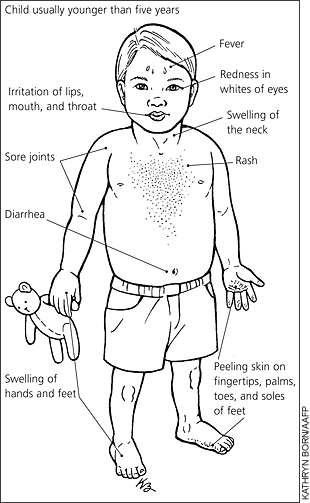
Am Fam Physician. 2006;74(7):1149-1150
See related article in Kawasaki disease.
What is Kawasaki disease?
Kawasaki (say: kah-wah-SOCK-ee) disease is an uncommon illness that affects children younger than five years. It can cause these symptoms (see drawing):
Fever
Rash
Redness in the white part of the eye
Swelling of the hands and feet
Irritation of the lips (it can look like chapped lips), mouth, and throat
Swelling of the neck

What causes Kawasaki disease?
No one knows what causes this disease. Doctors do know that this disease does not spread from person to person. Without treatment, about one in five children with Kawasaki disease will develop heart problems. With treatment by day 10 of the illness, only about one in 50 children develops a heart problem.
How can my doctor tell if my child has Kawasaki disease?
There is no exact test for this disease. If your child has symptoms of the disease, your doctor will need to rule out other illnesses. Some children with this disease do not have all of the symptoms. A physical examination of your child and blood and urine tests can help your doctor tell if your child has this disease.
How is it treated?
Kawasaki disease is treated with a medicine called IVIG made from blood and with high doses of aspirin. Your child will need to stay in the hospital for this treatment. Children who are treated early are less likely to have heart damage. Most children feel much better within one or two days of starting treatment.
The skin on your child’s fingers and toes may start peeling a few weeks after he or she gets sick. This will go away by itself in a few days and does not need to be treated.
What happens after treatment?
Most children with Kawasaki disease can go back to normal activities after they get home from the hospital. It may take a few days or weeks for them to feel back to normal.
Your child will need repeat tests to be sure there was no heart damage. These tests are done about two weeks and two months after treatment. Some children may need more tests if they have heart problems. Your child probably will not get Kawasaki disease again.
Some childhood shots, like the chickenpox vaccine and the vaccine for measles, mumps, and rubella, should not be given for 11 months after treatment for Kawasaki disease. Your doctor can tell you when it is okay for your child to get these shots.
Where can I get more information?
Your doctor
Kawasaki Disease Foundation
P.O. Box 45
Boxford, MA 01921
Telephone: 1-978-356-2070
Web site:http://www.kdfoundation.org